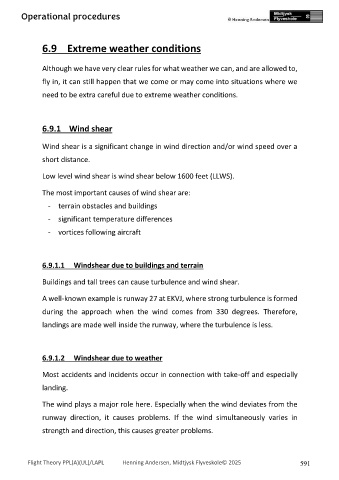Page 591 - PPL-engelsk 2025
P. 591
Operational procedures
6.9 Extreme weather conditions
Although we have very clear rules for what weather we can, and are allowed to,
fly in, it can still happen that we come or may come into situations where we
need to be extra careful due to extreme weather conditions.
6.9.1 Wind shear
Wind shear is a significant change in wind direction and/or wind speed over a
short distance.
Low level wind shear is wind shear below 1600 feet (LLWS).
The most important causes of wind shear are:
- terrain obstacles and buildings
- significant temperature differences
- vortices following aircraft
6.9.1.1 Windshear due to buildings and terrain
Buildings and tall trees can cause turbulence and wind shear.
A well-known example is runway 27 at EKVJ, where strong turbulence is formed
during the approach when the wind comes from 330 degrees. Therefore,
landings are made well inside the runway, where the turbulence is less.
6.9.1.2 Windshear due to weather
Most accidents and incidents occur in connection with take-off and especially
landing.
The wind plays a major role here. Especially when the wind deviates from the
runway direction, it causes problems. If the wind simultaneously varies in
strength and direction, this causes greater problems.
Flight Theory PPL(A)(UL)/LAPL Henning Andersen, Midtjysk Flyveskole© 2025 591

